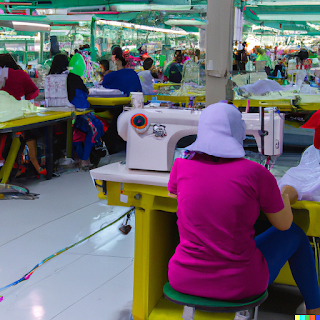Introduction
- The textile industry is a significant contributor to Bangladesh's economy, accounting for 83% of the country's export earnings.
- Despite its importance, many people are unaware of the textile industry's inner workings in Bangladesh.
- This article will provide you with ten interesting facts about the textile industry in Bangladesh that you probably didn't know.
The Ready-made Garments Industry in Bangladesh
- Bangladesh is the second-largest exporter of ready-made garments in the world, after China.
- The ready-made garments industry plays a crucial role in Bangladesh's economic growth, accounting for more than 80% of the country's export earnings.
- Labor costs and working conditions are major challenges faced by the industry, with low wages and poor working conditions often reported.
- Efforts are underway to improve working conditions and wages, with the Bangladesh government increasing the minimum wage for garment workers in 2021.
Women's Empowerment in the Textile Industry
- Women play a significant role in the textile industry in Bangladesh, with more than 80% of the industry's workforce being female.
- The textile industry has helped to empower women in Bangladesh, providing them with economic opportunities and greater independence.
- Efforts are underway to promote gender equality in the workplace, with initiatives like the SHEVA project focusing on promoting women's entrepreneurship and leadership.
Impact of COVID-19 on the Textile Industry
- The COVID-19 pandemic has had a significant impact on the textile industry in Bangladesh, with many factories forced to shut down temporarily.
- The industry has taken measures to cope with the crisis, including implementing health and safety protocols in factories and providing support to affected workers.
- The future outlook for the industry post-pandemic is uncertain, with supply chain disruptions and decreased demand for textiles affecting the industry's growth.
Sustainability in the Textile Industry
- The textile industry in Bangladesh is increasingly focused on promoting sustainability, with initiatives like the Better Cotton Initiative and the Sustainable Apparel Coalition working to improve environmental and social standards in the industry.
- However, the industry faces several challenges in adopting sustainable practices, including limited access to sustainable raw materials and high production costs.
- Supply chain transparency and responsible sourcing are critical to the industry's growth and competitiveness in the global marketplace.
The Textile Industry's Role in Community Development
- The textile industry in Bangladesh has contributed significantly to social and economic development in the country, with many companies initiating community development projects.
- Collaboration between industry stakeholders and local communities is essential to promoting sustainable development in the industry.
- The industry has a vital role to play in promoting social and economic development in Bangladesh.
Multinational Companies and the Textile Industry in Bangladesh
- Multinational companies play a significant role in the textile industry in Bangladesh, with many outsourcing their textile production to Bangladesh due to the country's low labor costs.
- Outsourcing has brought benefits to Bangladesh, including increased employment opportunities and economic growth.
- However, multinational companies also face challenges in working with the industry, including ensuring ethical and sustainable production practices.
Innovations and Future Trends in the Textile Industry
- The textile industry in Bangladesh is increasingly focused on technological innovations, with many companies adopting new machinery and production techniques to improve efficiency and quality.
- Future trends in the industry include increased automation and digitalization, as well as a focus on sustainable and ethical production practices.
- Workforce development and training are essential to the industry's growth and competitiveness in the global marketplace.
Conclusion
In conclusion, the textile industry is a critical sector for Bangladesh's economy and social development. It has played a significant role in empowering women, creating jobs, and driving economic growth. However, the industry has faced various challenges, including labor costs, working conditions, and sustainability issues.
To overcome these challenges and continue to grow sustainably, the industry stakeholders need to work together, including multinational companies, governments, industry associations, and local communities. Efforts to improve working conditions and wages for textile workers, promote gender equality in the workplace, and adopt sustainable practices must continue.
Moreover, innovation and technology adoption, workforce development, and supply chain management are crucial for the industry's future growth and competitiveness. With the right policies, regulations, and certifications in place, Bangladesh's textile industry can achieve its full potential and remain a leading global player. Overall, the textile industry in Bangladesh has a bright future, and its success will undoubtedly continue to drive the country's economic and social progress.


Comments
Post a Comment